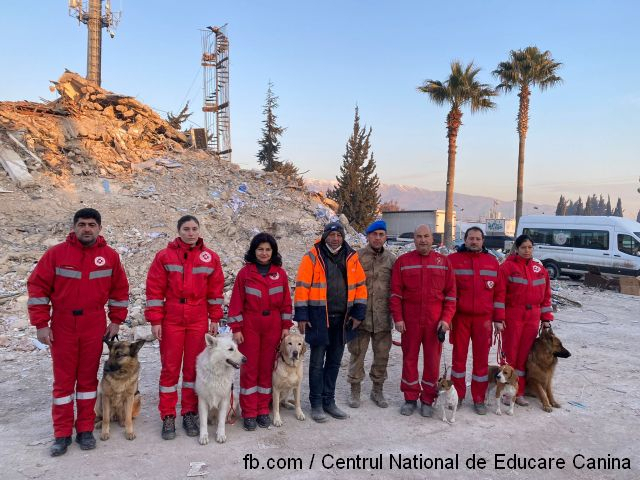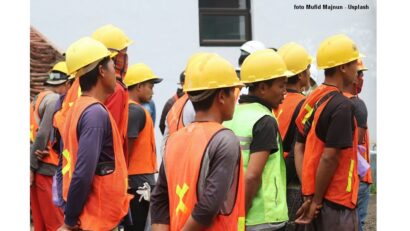People and dogs at the service of society
The earthquakes that hit Turkey in February brought to the forefront a special category of rescuers

Roxana Vasile, 19.07.2023, 12:01
The earthquakes that hit Turkey in February brought into the attention of domestic and international public opinion a special category of rescuers – mixed teams made up of humans and dogs, called to the rescue of those on the edge between life and death.
Liviu Ionescu leads the National Canine Training Center, based in Craiova (south). A volunteer himself in Turkey, he is one of the Romanian specialists best able to explain to us why it is important to train dogs for search-rescue missions:
“At the National Canine Training Center, we, for about 30 years, have been trying to create a database of search-rescue dogs for all specialties in this activity, namely rescue tracking dogs, dogs that search for missing persons, dogs searching for people under rubble, or dogs that rescue people from water or urban tracking (persons missing from urban areas). These are the specialties that we are trying to develop in Romania! Why? Because, in addition to the sporting canine aspect, of training puppies and increasing their intelligence, not only beauty, the social aspect is particularly important, actually a necessity for all areas, regions, cities to have search-rescue dogs for any type of emergency situation, for any disaster, be it natural or technological. And we are trying to raise awareness about this, among animal lovers, animal breeders, whether they are members of the Romanian Canine Association or a working club, to test each of their canine specimen.”
The selection of rescue dogs is very tough and realistic. Whether they are brought by their owners who want to evaluate their qualities or they are discovered by the specialists of the Canine Training Center, they have to meet very strict requirements to certify their qualities. It is the reason why only 5-10% maximum of the dogs tested in several stages -darkness, fire, height, etc. – are able to start training courses to become professional rescuers, as Liviu Ionescu also explains:(track) “It joins an educational program and depending on its temperament, character, adaptability coefficient, the age at which it starts, the area the dog is from and where it lives, its daily area and depending on the specialty where we direct it, the training can last 6 months, but it can also last 2 years. There are some educational modules designed for such puppies, and after 2 years, maybe even 3 of intensive training, they take some official international exams, where their value is seen. They have to go through some levels of training and examination, and after getting through all these levels of examination, they can participate or even be admitted into the national team and from there the step to the World Rescue Championship is big. Then they get into an international database to be called for help in real situations.”
The tests used by canine training specialists apply to any type of dog, in other words there is no specific breed predestined for search and rescue activities. Conversely, the earlier a dog is tested, even at the age of 3-4 months, the faster it can enter the actual educational process. Once prepared, it is fit to act. With what performance? According to the president of the National Canine Training Center, the dog is able, for example, to penetrate extremely sensitive places, up to 2-3 meters deep, including where even high-performance electronic audio-video systems would be impossible to use. Then, in theory, a search and rescue dog for missing persons, for example, can cover an area of 50,000 m² in 20 minutes, at least three times better than any professional human team. In a human-dog tandem, this relationship changes to the detriment of the human, hence the need for compatibility bordering on perfection with the dog.
Romanian search-rescue dogs do win awards at international canine competitions. But where does Romania stand, externally, from the perspective of the training of dogs? Here is Liviu Ionescu again with the details:
“Romania is considered at the beginning of the search-rescue activity. Other countries started these human-canine selections before the world wars, but we started in the late 80s, and only after 93-94 we can talk about a serious development according to international standards. The National Canine Training Center has a database of about 30 search and rescue dogs. The problem is that, unfortunately, the life and the active time of a dog is much shorter. They and we prepare for any cataclysmic situation, at any time. Unfortunately, they can help us for up to 7, 8, 9 years. We are in a constant race against time to have a certain number of dogs. They would be willing to help even up to the age of 14, unconditionally, but we have to think about their health and- we use them between 3 years and 7, 8, 9 years at the latest, because, otherwise, problems can arise and they can no longer perform at an optimum level as rescue dogs.”
In other words, says Liviu Ionescu, president of the National Canine Training Center, one can never say there are enough search-rescue dogs in a country, a region or a continent. The discovery and training of these quadrupeds that prove exceptional qualities must be continuous. Moreover, after the earthquakes in Turkey, the need for reorganization with a view to increased coordination between states became obvious. Here is Liviu Ionescu once more:
“We are in full program of reorientation, rethinking of the intervention strategy, of communication and joint multinational trainings. I am coordinating this program at world level, and I see the applicability, the speed, the intensity, the human thinking in certain areas of the world and I am glad that we are starting to become more effective in such real situations and we are crossing the sports threshold, the World Championship being considered, until the earthquake in Turkey, the most important event. Well, things have started developing in this field just as it happens in IT and everything flows very quickly. You have to be forward-thinking, wondering whats going to happen to the performance of the rescue canine team in 5 years, 10 years, given that earthquakes and other situations in which people get missing are not over we must be prepared for any type of activity where search and rescue dogs can become a real rescue tool. Following our performance in Turkey and the results we scored at the last three editions of the World Championship of the International Canine Federation – we are talking about the World Team Championships, Romania is vice-champion and world champion, for example, in the ʹtrackingʹ section – we have some results, we have a certain, lets say, mentality. I developed this project worldwide, it even bears my name, and it is clear that Romania, in Craiova, is an important when it comes to rescued dogs.”
Because, yes, search and rescue is much more than a canine sporting activity, it is one of unconditional, humanitarian, social aid!






























